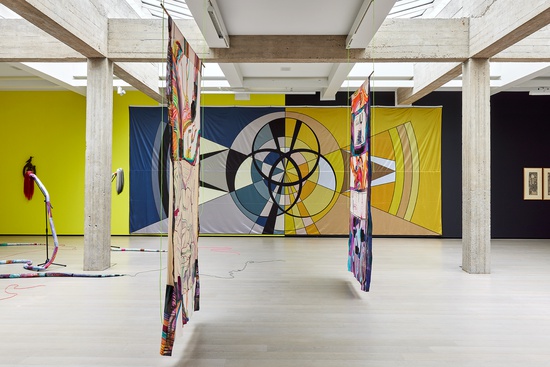11. Open Thoughts: Birth
Emma Talbot
(2017)
Four figures stoop over their microphone stands, heads bowed under limp wigs in glam rock shades – cobalt blue, two-tone grey, unnatural red. They are snakes, with patchwork skins of iridescent quilting and swirling space prints. Trailing on the floor, their looping bodies taper into pink cord, like electrical cabling. Are these microphones or performers? Though they are clipped onto their stands, they turn towards us, poised as if ready to burst into song, inviting us to listen. Titled Snake Raising, this work by Emma Talbot has a performative flair, conjuring objects into action.
Subject of fear and fascination, snakes are of course a symbol of the pagan. They are almost always associated with the spiritual, but also seduction, luxury and the devil, who takes serpent form to tempt us. Ouroboros, the ancient symbol of the snake devouring itself, heralds the unending cyclical nature of the universe, proliferating in a regenerative loop. But these snakes are not circular: they are plucked from the ground and clipped to microphone stands, summoned to rise and break their silence. Despite their recasting as reluctant rock stars, they feel playful, tentative. These are not smooth temptresses, but shy, mischievous serpents, hiding behind trails of synthetic hair.
Elsewhere, two silk banners hang from the ceiling in vertical shafts. They are painted with whorling patterns—almost psychedelic, but darker, ominous. Curvilinear forms jump from banner to banner, continuing the same offbeat energy, while stripes in vibrant colours are layered like geological rock formations or cross-sections of the earth’s core. Organic forms resembling stamen and stigma, the sex organs of plants, reach upwards and the vegetal world seems to come alive. Silk banners are a cornerstone of Talbot’s practice, and paintings from her wider body of works might include song lyrics (Cyndi Lauper’s Time After Time), abject, spiky versions of affirmations (“Plant Your Scraps of Hope, Grow Stronger”) or feelings of longing and yearning, talking of bodies compressing, self-expression, hyperreality. All this unfolds across storyboard-style panels and comic strip fragments of text, bringing us on a narrative journey.
The lowbrow beat of comic books and pop songs are at odds with the sumptuousness of the silk fabric, the decorum of a textile wall hanging, which feels regal, even Renaissance, in spirit. If textiles, tapestries and handicrafts have always been deemed feminine, this is a fresh way to reclaim them. On the flipside, it also liberates painting from the weight (both literal and figurative) of the canvas and from the confines of the wall. As hangings, they behave more like sculptures, which we can stalk and circle in a 360 rotation. As with the snakes, our attention is drawn to the gravity of these objects which hang from the ceiling by coloured cord.
Reclining figures seem to repeat across Talbot’s silk panels, the cross sections of their bodies sometimes visible in their hollow outlines, as in an illustration of chakras. Sometimes these linear outlines are layered, multiplied, suggesting a stop-motion style movement of limbs; a bent knee echoing several times across a panel. One figure here seems to be draped over the summit of a volcano, becoming one with the linear plumes of smoke blowing over its crater as it coughs up lava. A potent symbol of danger and renewal, this conical form and its protrusion of limbs feels live, charged, desiring, reactive. Volcano as female body, it denotes a rupture in the old order and outpouring of a red hot pyroclastic flow of new actions and ideas. Whether this eruption is generative or destructive, revolutionary or apocalyptic, is unclear.
As with Talbot’s snakes, who rise up and seize the microphone, the seismic rumblings depicted on the artist’s silk panels show a natural world in flux, an undoing of the usual order of things, a response from the earth’s core. As we journey through this mind-bending, agitated and beautifully mapped universe, we hear the tinklings of a natural world that begins to answer back.
Text by Rosa Abbott



